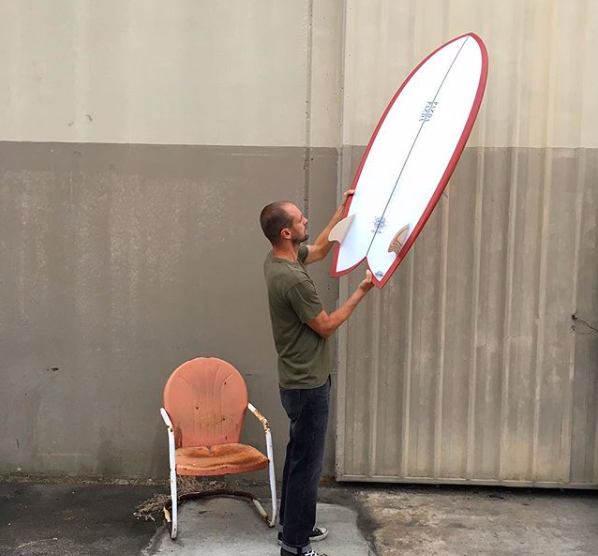So You Want to Surf A Twin Fin
So You Want to Surf a Twin Fin
Everything you’ve ever wanted to know about ordering your first twin fin, from Blake Peters and Steve Brom
Blake Peters // Panda Surfboards. Photo: @pandasurfboards Instagram
Steve Brom // Surf Engines. Photo Courtesy: Steve Brom
April 6, 2020 by Mike Chuthakieo
Disclaimer: Of the many articles written about the history of the twin fin surfboard, this is not one of them. From Bob Simmons’ experimentation with dual fin designs during the 1940’s, to Mark Richards’ four world titles won between 1979-1982 on his self-shaped twins, the evolution of the twin fin surfboard has been well documented and discussed.
The inspiration for this feature on twins is desire. I want one. Spend some time watching South African style master, Mikey February, surf a twin fin at J-Bay and you’ll question why you haven’t added one to your quiver yet. That’s exactly what happened to me. While I’ve always appreciated the outlines of a traditional twin fin fish, and have had my curiosity drawn to the modern, performance driven variations, I’ve yet to add one to my quiver. Blasphemy?
Like most average surfers, I’ve got a very select go-to board choice that allows me to maximize my very limited surf time with what I think will get me into the most amount of waves, while having the most amount of fun. As much as I’ve wanted to order a twinnie, I’ve refrained as a result of one very simple question: What will it come at the expense of? After all, board choice can make or frustrate any given session, right? Maybe.
Over time though, I’ve come to remind myself of a few basic facts: 1) I’m probably over thinking it, 2) twin fins look super fun to surf, and 3) I like surfboards.
To better understand how one should go about ordering a twin fin, I asked Steve Brom of Surf Engines and Blake Peters of Panda Surfboards to answer a few of the most commonly asked questions.
Steve’s shaping roots go back to the 1970’s, where he was the head shaper at Dyno Surfboards in Huntington Beach, CA. There he shaped boards for guys like, David Nuuhiwa and Corky Carroll, among other Dyno team riders. It was during this time he created the Rocket Fish, otherwise known as the Gun Fish under the Dyno label. He now shapes out of Santa Barbara, CA.
Blake’s shaping roots go back to the northern beaches of Sydney, Australia, but also calls California ‘home.’ Teaming up with guys like Ford Archbold not only inspired Blake to bring his Panda Surfboards label to the US, it also pushed him towards unconventional board designs. The result is an extremely eclectic and wide range of surfboard models fit for every style of surfer.
The average, every day surfer probably has one or two go to boards; maybe a hybrid/groveler and an everyday thruster. Why should they consider adding a twin fin to their quiver?
Blake Peters: Twin fins have great speed and flow and its a different style of surfing in general; a little more graceful and less aggressive. Twins are great if you are surfing somewhere that has a point break or a wave that lets you run and gives you some open face. Not only that, but they can be incredibly fun on small days. Its good for your surfing to ride different boards and mix it up.
Steve Brom: If it's made properly it's one of the funnest, most playful surfing sessions possible. It's a design that excels in junkie crappy surf, because you can learn to make it go faster. It is so incredibly fast and sensitive in great clean and glassy surf, that it seems surreal. A board like this should be a part of every option in the quiver. I tell my customers to ride it in any size wave that they can catch.
Mike February’s twin fin cutback at J-Bay
Twin fins seem to be going through yet another resurgence lately, as the availability of traditional twin keel fishes and more high performance variations have become commonplace. What should surfers consider when trying to pick the right twin fin shape?
Blake Peters: I would say think about the type of surfing you want to do and what you want to get out of a twin fin. Then think about the waves that you are surfing. The more classic styles are generally more suited to better cleaner waves with some open face, so think a good, fun 3-4ft day on a point break and you will have a blast on a classic style fish. If you’r surfing beach breaks where its a bit more unpredictable or you want to still be a little aggressive with your turns when given the chance, then a more modern style fish will do the job.
Steve Brom: I suggest start with a classic fish, and commit to a short learning curve. Consider the board builders history. It's easy to make this board wrong. What could be so hard? Wide nose, wide tail, deep split and two fins. Well, today's well-made fish is a science of complementary components. Wider nose for soft breaking waves as opposed to a narrower nose for critical steep and under the lip.
You've come out with several models, from more traditional outlines to derivatives of the classic fish design. Which board model do you steer most surfers towards when ordering a twin fin?
Blake Peters: I don’t steer them towards any one model in particular. I ask them what twin they see themselves riding, where they are going to ride it, etc. All of my models serve a different purpose. Most customers already have a pretty clear idea in their mind when they come in, so it’s more a matter of helping them dial it in to suit them. My most popular twin is my Astro Zombie, which is my classic version. A lot of customers seem to go to that one first because they want to get that classic twin fin experience. From there they usually want something like a performance twin with a trailer to replace their small wave performance board. Once they have those two, most conditions are covered on a day to day basis.
“If it's made properly it's one of the funnest, most playful surfing sessions possible.”
- Steve Brom
You've been shaping twin fins since 1970; that's 50 years of knowledge and refinement that's gone into the Brom Fish. What have you learned most about the value of surfing a twin fin, that you impart on surfers who order from you?
Steve Brom: It's the board choice that makes the potential of super-fun surfing a reality. This board allows you to go places on a wave that other designs won't allow. Specifically it allows the rider to travel and stay much higher on the face of the wave. It also allows the rider to pump the board from side-to-side creating forward momentum and building speed from where there was none. It also has an amazing holding power built into the idea that the fins are located away from the center line towards the outline of the board.
Is there a world where the twin fin becomes the preferred every day board for the average surfer, in average or good waves?
Blake Peters: Here in southern CA, yes, I think it totally can be. The waves are always gutless and small, which is perfect for the twin. I personally ride them and quads more often than a thruster these days. Its very easy to get hooked on twins; more speed, more fun!
Steve Brom: Most of my customers have experienced a world where the fish has become the board that rocked their world, from how they used to surf in it. When you learn to go wherever you want to go with ease and effortlessly glide on a wave, using your own timing, rather than the timing the wave dictates. There is an addiction that develops riding this board that usually ruins one's quiver choices for a long while. And maybe for good. I've heard many stories where "go-to boards" have been mothballed as people just couldn't get enough. All it takes is that one special wave and you're hooked for a good long time.
Any parting advice on how to surf twin fins to bring out the inner style master that lives inside us?
Blake Peters: Yes! Don’t go pumping them aggressively down the line like a 2-1/4” shortboard, let the board do the work. With twins you can generally slow yourself down and relax. It’s not about 3 to the beach.
Steve Brom: The inner style-master fish rider will have opportunities to let their skateboard skills, snowboard skills and basic wave riding instincts show up in a great big way. Pump this twin fin fish through the flats, to the next section. Unweight and let the planing surface glide on, tying different directions together on each wave. My goal with a board design like this is to tailor it to the surfers abilities and make it disappear from the surfing experience. To allow the surfer to interact with the wave without the distraction of the board's presence; the wave, the board, and the surfer. Let's get the surfer and the wave together and hope the board blends as one with the mind.
To learn more about Blake Peters’ lineup of twin fins, visit Panda Surfboards
To learn more about Steve Brom and the Brom Fish, visit Surf Engines




